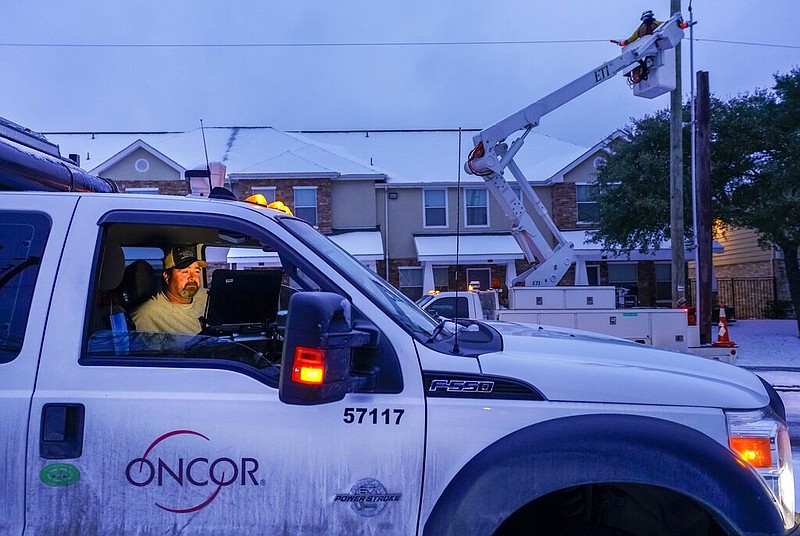AUSTIN, Texas — Power was restored to more Texans on Thursday, with fewer than a half-million homes remaining without electricity, and many still were without safe drinking water after winter storms wreaked havoc on the state's power grid and utilities this week.
Meanwhile, the Appalachians, northern Maryland and southern Pennsylvania braced for heavy snow and ice. Snow fell in Connecticut, New Jersey and New York.
Little Rock got 15 inches of snow in back-to-back storms, tying a 1918 record, the National Weather Service said.
More than 320,000 homes and businesses were without power in Louisiana, Mississippi and Alabama. In Tennessee, 12 people were rescued from boats after a dock weighed down by snow and ice collapsed on the Cumberland River on Wednesday night, the Nashville Fire Department said.
The extreme weather has been blamed for the deaths of more than three dozen people, some of whom perished while struggling to keep warm. In the Houston area, one family succumbed to carbon monoxide from car exhaust in their garage. A woman and her three grandchildren died in a fire that authorities said might have been caused by a fireplace they were using.
[Video not showing up above? Click here to watch » https://www.youtube.com/watch?v=Tm6xvldz_n8]
In Texas, just under 500,000 homes and businesses remained without power, down from about 3 million on Wednesday. The state's grid manager, the Electric Reliability Council of Texas, said the remaining outages are largely weather-related, rather than forced outages that were made early Monday to stabilize the power grid.
“We will keep working around the clock until every single customer has their power back on,” said ERCOT Senior Director of System Operations Dan Woodfin.
Adding to the misery, the weather jeopardized the state's drinking water systems.
Texas officials ordered 7 million people — a quarter of the population of the nation’s second-largest state — to boil tap water before drinking it, following days of record low temperatures that damaged infrastructure and froze pipes.
Some Austin hospitals faced a loss in water pressure and heat.
“Because this is a state-wide emergency situation that is also impacting other hospitals within the Austin area, no one hospital currently has the capacity to accept transport of a large number of patients,” said David Huffstutler, CEO of St. David's South Austin Medical Center.
[Gallery not loading above? Click here for more photos » arkansasonline.com/218texas/]
Water pressure has fallen because lines have frozen, and many people left faucets dripping in hopes of preventing pipes from icing over, said Toby Baker, executive director of the Texas Commission on Environmental Quality.
Gov. Greg Abbott urged residents to shut off water to their homes, if possible, to prevent more busted pipes and preserve pressure in municipal systems.
At Houston Methodist, two of its community hospitals did not have running water but still treated patients, with most non-emergency surgeries and procedures canceled for Thursday and possibly Friday, said spokeswoman Gale Smith.
Pipes had burst in Methodist’s hospitals but were being repaired as they happened, Smith said.
Texas Children’s Hospital’s main campus at the Texas Medical Center and another location had low water pressure, but the system was adequately staffed and patients had enough water and “are safe and comfortable,” spokeswoman Jenn Jacome said.
The hospitals were “all experiencing very crowded emergency rooms due to patients being unable to meet their medical needs at home without electricity,” she said.
Weather-related outages also struck Oregon, where some customers have been without power for almost a week. A Portland supermarket threw its perishable food into dumpsters, leading to a clash between scavengers and police.
The damage to the power system was the worst in 40 years, said Maria Pope, CEO of Portland General Electric. At the peak of the storm, more than 350,000 customers in the Portland area were in the dark. More than 100,000 customers remained without power Thursday in Oregon.
“These are the most dangerous conditions we’ve ever seen in the history of PGE,” said Dale Goodman, director of utility operations, who declined to predict when all customers would have power restored.
Utilities from Minnesota to Texas have implemented rolling blackouts to ease the burden on strained power grids. Southwest Power Pool, a group of utilities covering 14 states from the Dakotas to the Texas Panhandle, said rolling blackouts were no longer needed but asked customers to conserve energy until at least 10 p.m. Saturday.
The weather also disrupted water systems in several Southern cities, including New Orleans and Shreveport, Louisiana, where fire trucks delivered water to hospitals and bottled water was brought in for patients and staff, Shreveport television station KSLA reported.
Power was cut to a New Orleans facility that pumps drinking water from the Mississippi River. A spokeswoman for the Sewerage and Water Board said on-site generators were used until electricity was restored.
This story has been updated. It was originally published at 8:14 a.m.
